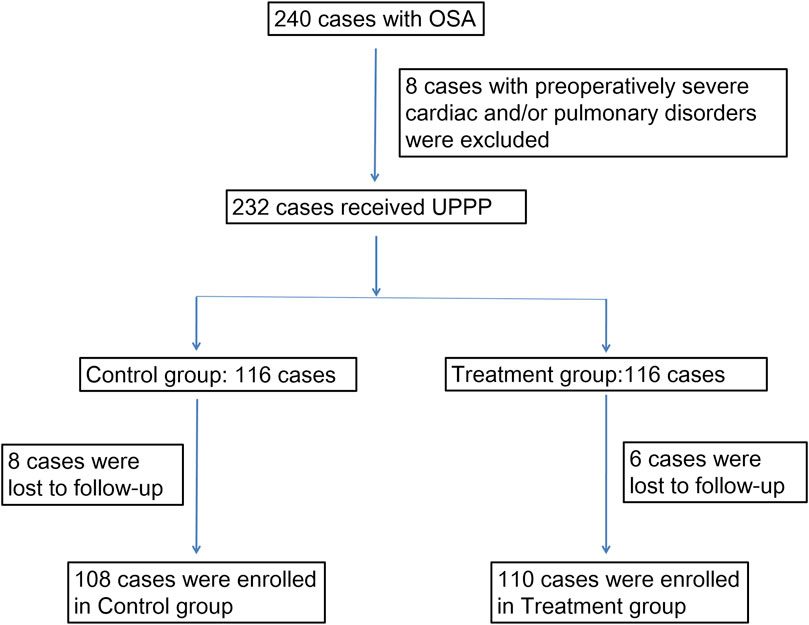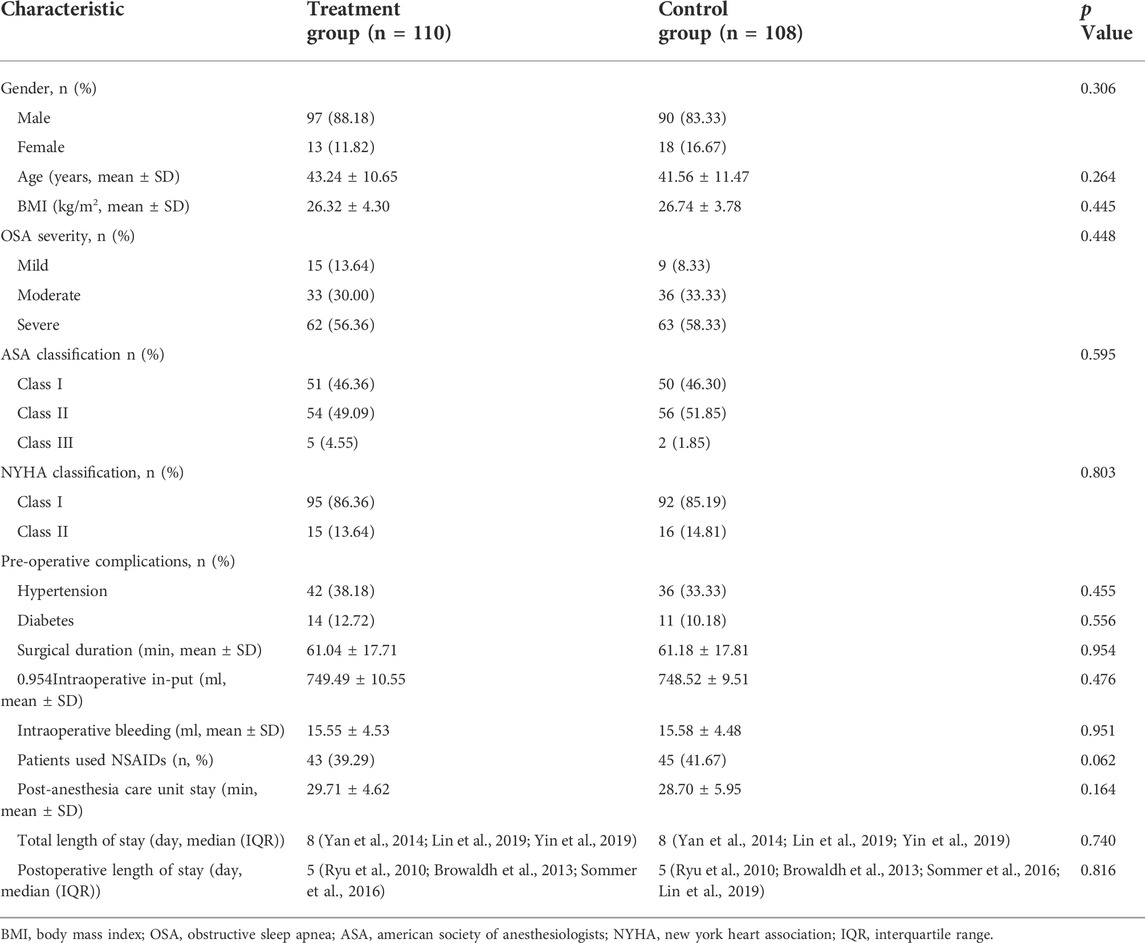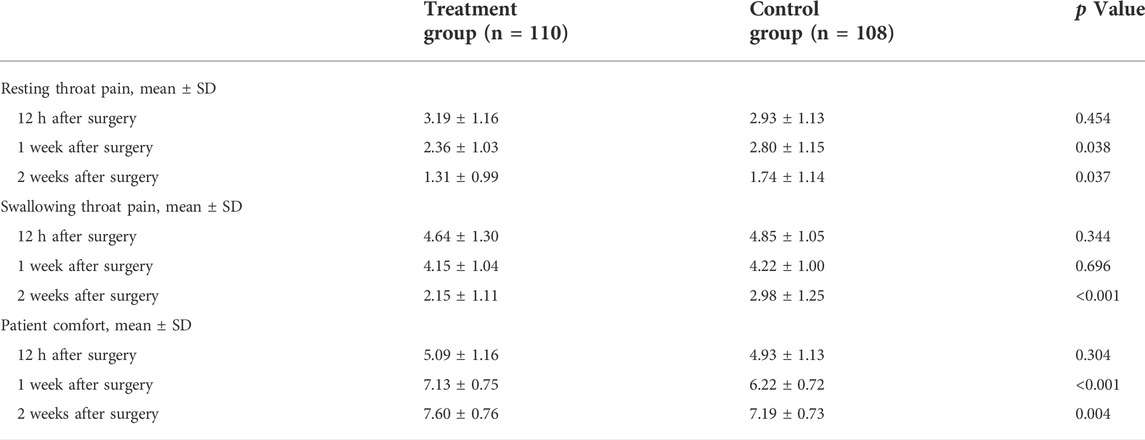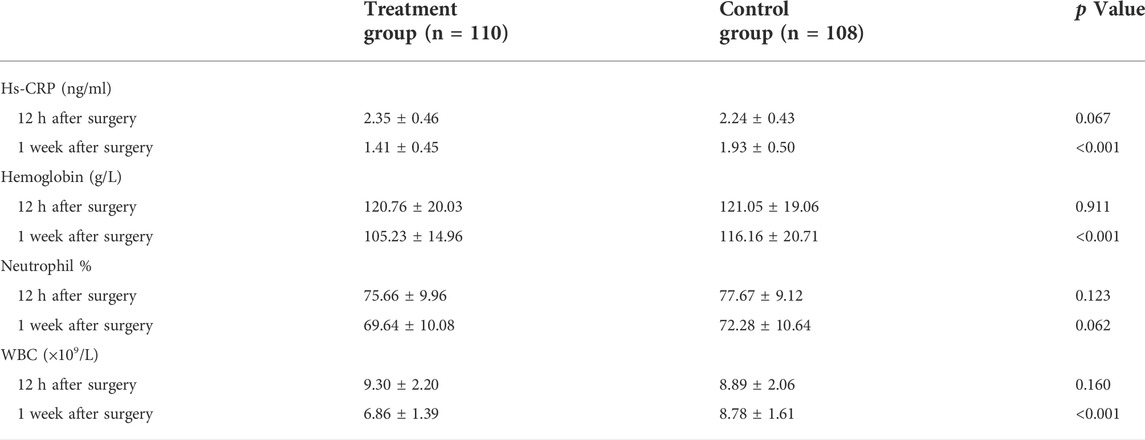- Department of Otorhinolaryngology Head and Neck Surgery, Hebei Provincial Hospital of Traditional Chinese Medicine, Hebei, China
Purpose: The main purpose of this pilot study was to detect the positive effects of our self-made gargle containing honeysuckle and semen oroxyli on post-operative pain and complications after Uvulopalatopharyngoplasty (UPPP).
Methods: Patients with obstructive sleep apnea (OSA) who had underwent elective UPPP during the period of April 2019 to January 2022 were randomly divided into treatment group and control group. The patients in the treatment group were instructed to gargle the solution containing honeysuckle and semen oroxyli (25 ml) four times a day for 2 weeks. The patients in the control group were instructed to gargle normal saline (25 ml) at the same schedule. The post-operative resting throat pain, swallowing throat pain and patient comfort level were evaluated at 12 h, 1 week and 2 weeks after UPPP. The post-operative complications were collected and analyzed.
Results: During the study period, 218 patients completed all the post-operative assessments. For resting throat pain, the treatment group had much lower VAS scores at 1 week and 2 weeks after UPPP. For swallowing throat pain, treatment group had much lower VAS scores than control group at 2 weeks after surgery. And patients in the treatment group felt more comfortable comparing to those in control group at 1 week and 2 weeks after UPPP. Although the treatment group had less numbers of patients with post-operative wound infection or bleeding, the difference between the 2 groups was not statistically significant.
Conclusion: The gargle containing honeysuckle and semen oroxyli could relieve both resting and swallowing throat pain and increase patient comfort after UPPP.
Introduction
Obstructive sleep apnea (OSA) is a common disease characterized by repetitive upper airway collapse during sleep (Lee et al., 2021). Over 4% of men and 2% of women in the world are affected by this disease (Franklin and Lindberg, 2015). Untreated OSA is associated with a series of serious cardiovascular complications such as hypertension, coronary artery disease and heart failure, with increased mortality (Huang et al., 2021). Various neurodegenerative disorders have also been suspected to be associated with OSA (Lee et al., 2021).
Uvulopalatopharyngoplasty (UPPP) is the major treatment for OSA, which could relieve the obstruction of upper airway via shortening the uvula and soft palate or in company with tonsillectomy (Huang et al., 2021). The efficacy of UPPP to treat OSA has been demonstrated in two former randomized controlled trials (Browaldh et al., 2013; Sommer et al., 2016). However, post-operative pain and complications after UPPP may negatively impact the quality of life (QOL) and postoperative comfort of patients, leading to delayed recovery. Thus, finding a strategy to relieve post-operative pain and complications is important for perioperative management of UPPP.
Honeysuckle (Lonicera japonica Thunb) is a semi-evergreen vine shrub that grows in China, Japan and Korea (Ryu et al., 2010). It is well-known Chinese botanical drug, which has been long used as anti-bacterial, anti-viral, anti-oxidative and anti-inflammatory agents (Lin et al., 2019). The anti-inflammatory and analgesic activities of honeysuckle have been demonstrated in a variety of disease models (Ryu et al., 2010). It is a good candidate of phytomedicine to relieve pain and inflammatory. In China, honeysuckle is often used to treat throat pain. Semen Oroxyli is the seed of Oroxylum indicum (L.) Vent., which grows widely in the tropic regions in China (Yin et al., 2019). Modern pharmacological studies have demonstrated that semen oroxyli possesses antioxidant and anti-inflammatory activities (Yan et al., 2014). It is often used to treat respiratory disorders including coughs, chronic pharyngitis, and upper respiratory tract infections (Yan et al., 2014; Yin et al., 2019).
As mentioned above, both of honeysuckle and semen oroxyli have antioxidant and anti-inflammatory activities. Thus, the gargle containing honeysuckle and semen oroxyli has the potential to relieve pain and complications (such as wound infection and wound bleeding) after UPPP. The main purpose of this pilot study was to detect the positive effects of our self-made gargle containing honeysuckle and semen oroxyli on post-operative pain and complications after UPPP.
Materials and methods
This study was registered at https://register.clinicaltrials.gov (registration number: ClinicalTrials.gov Identifier: NCT05535179). We used a Revised Cochrane risk-of-bias tool for randomized trials (RoB 2) to evaluate the methodological quality of the present study (See Supplementary Material).
Preparation of gargle
Honeysuckle (Lonicera japonica Thunb), Semen oroxyli (Oroxylum indicum L), Prunella vulgaris (L), Wax gourd (Benincasa hispida) peel, Euchresta japonica (Sophora tonkinensis Gagnep.), Rehmannia glutinosa (Rehmannia glutinosa Libosch.) and Arnebiae Radix [Arnebia euchroma (Royle) Johnstn]. were obtained from Zhang Zhongjing Pharmacy (Henan, China). Honeysuckle (20 g), Semen oroxyli (15 g), Prunella vulgaris (30 g), Wax gourd (Benincasa hispida) peel (20 g), Euchresta japonica (6 g), Rehmannia glutinosa (10 g) and Arnebiae Radix (10 g) were ground into powder using a high-speed tissue crusher (AF-10A; Auari, Wenling, China). 15 g of mixed medicinal powder was totally dissolved in 500 ml of hot water.
Patients
This was an open-label randomized controlled study which was approved by Institutional Review Board of our hospital. Patients with OSA, aged 18–60 years, who had undergone elective UPPP during the period of April 2019 to January 2022 were enrolled in this study. All of them signed the informed consents to publish the data.
In this study, OSA was diagnosed through polysomnography according to the international classification of sleep disorders approved by the America Academy of Sleep Medicine (Huang et al., 2021). The exclusion criteria were as followed: (Lee et al., 2021): patients with a history of systemic diseases such as severe cardiac and/or pulmonary disorders; (Franklin and Lindberg, 2015); patients who were unable to cooperate with evaluations; (Huang et al., 2021); patients with severe diabetes; (Sommer et al., 2016); patients who had underwent other surgeries in the last 6 months.
The patients were randomly divided by a computer-generated simple randomization schedule into treatment group and control group in a 1:1 ratio.
Surgery
All patients in this study used Chengdu Meichuang low-temperature plasma surgery system PLA-600.
The operation was conducted through nasal intubation and general anesthesia. The disposable plasma surgical electrode tip: MC401 was selected.
Use a low temperature plasma knife to stop bleeding or cut. First, remove the tonsils on both sides, and cut the soft palate mucosa along both sides of the uvula in an inverted “U” shape.
The excessive fat tissue in the palatine velum space was ablated with plasma, and the palatopharyngeal arch and soft palate nasopharyngeal mucosa were preserved to avoid damaging muscle tissue (especially levator veli palatini and tensor veli palatini) as much as possible. The long and thick uvula tissue was partially ablated to fully stop bleeding.
Close the palatoglossal arch and palatopharyngeal arch mucosa on both sides with 4-0 absorbable suture, and clear the dead space. Avoid eating hard, overheated and irritating food after operation.
Treatments
The patients in both groups were given first generation or second generation cephalosporins for 3–5 days after UPPP. Except for these drugs, patients in the treatment group were instructed to gargle the suspension solution containing honeysuckle and semen oroxyli (25 ml) for 5 min. The solution was given 4 times a day for 2 weeks. The patients in the control group were instructed to gargle normal saline (25 ml) at the same schedule. No NSAIDs were administered unless requested by the patient.
Data collection
The post-operative resting throat pain and swallowing throat pain were evaluated at 0 weeks (12 h after surgery), 1 week and 2 weeks after UPPP by the patients themselves using a visual analog scale (VAS) based on a linear scale from 0 to 10, where 0 represented an absence of pain and 10 represented maximal pain. Then, the changes of scores from week 0 to week 2 between the 2 groups were compared. The VAS scores related to patient comfort level were also evaluated by patients themselves, with 0 representing very much worse and 10 very much comfort. Furthermore, the researchers who were blinded to the therapeutic regimens evaluated the improvement in postoperative pain of patients within the 2-weeks postoperative period based on the clinical global impression of improvement (CGI-I score) questionnaire. In this questionnaire, the researchers used a seven-point scale from 1 (very much improved) to 7 (very much worse) to rate the improvement of body pain of the patients (Huang et al., 2009).
The post-operative complications, such as wound infection and wound bleeding, were collected and analyzed. The baseline characteristics of the patients in 2 groups including age, gender, body mass index (BMI), OSA severity, American Society of Anesthesiologist (ASA) classification and pre-operative complications were also collected. The venous blood was collected at 12 h and 1 week after operation to detect the levels of hs-CRP, hemoglobin, neutrophil% and white blood cell count (WBC).
Statistical analysis
The data in this study were analyzed by the SPSS software (version 22.0). Normal distribution quantitative data were described as mean ± SD. The difference between groups were compared by the Student’s t test. Non-normal distribution quantitative data were described as median with range and compared with Mann-Whitney U test. Categorical data were described as numbers and percentages and compared using the Chi-square test or Fisher’s exact test. p < 0.05 was considered as statistical significance.
Results
During the study period, 240 patients with OSA were screened in this study (Figure 1). 8 of them were excluded for preoperatively severe cardiac and/or pulmonary disorders. 232 were randomly divided into treatment group (n = 116) and control group (n = 116). However, 6 patients in the treatment group and 8 patients in the control group were lost to follow-up. Finally, 218 patients completed all the post-operative assessments (n = 110 and 108 for treatment and control groups, respectively), the data of whom were included into the statistical analysis. The characteristics of the 2 groups are shown in Table 1.
For resting throat pain at 1 week and 2 weeks after UPPP, the VAS scores of the treatment group were much lower than those of the control group (p = 0.033 and p = 0.031, respectively, Table 2). However, the VAS scores for resting throat pain measured at 12 h after UPPP were not significantly different between the 2 groups (p = 0.465). For swallowing throat pain, treatment group had much lower VAS scores than control group at 2 weeks after surgery (p < 0.001). But the 2 groups had similar VAS scores for swallowing throat pain at 12 h and 1 week after surgery (p = 0.414 and 0.732, respectively, Table 2). Furthermore, patients in the treatment group felt more comfortable comparing to those in control group at 1 week and 2 weeks after UPPP (Table 2).
As shown in Figure 2, the changes of VAS scores for both resting and swallowing throat pain from week 0 to week 2 were significantly higher in treatment group than in control group (p < 0.001 and p = 0.005, respectively). In addition, the treatment group performed a lower GGI-I score than control group (p < 0.001, Figure 3), indicating patients in treatment group had a higher improvement of body pain.
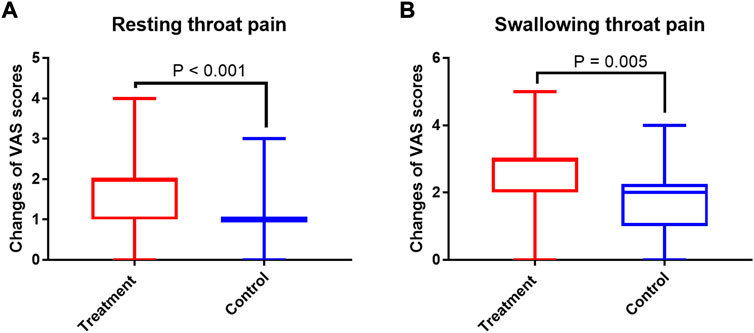
FIGURE 2. The comparisons of changes of VAS scores for resting throat pain (A) and swallowing throat pain (B). VAS, visual analogue scales.
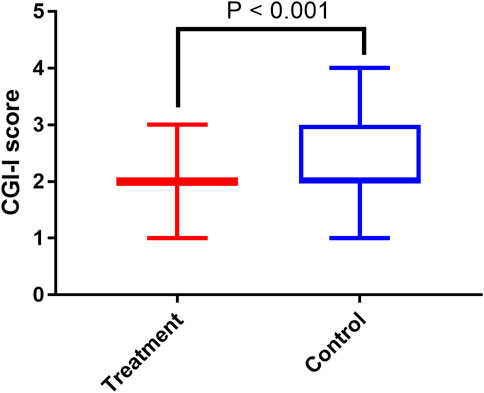
FIGURE 3. The comparison of CGI-I scores in treatment and control groups. CGI-I, clinical global impression of improvement.
No deaths occurred within the 2-weeks postoperative period. The total complication rates between the 2 groups was not significantly different (p = 0.071). Although the treatment group had less numbers of patients with post-operative wound infection or wound bleeding, the difference between the 2 groups was not statistically significant (Table 3). The sub-analysis of complications is presented in Table 3.
The levels of hs-CRP, hemoglobin, neutrophil% and WBC between the 2 groups at 12 h after surgery were not significantly different. 1 week after operation, the levels of hs-CRP, Hemoglobin, and WBC in the treatment group were significantly lower than those in the control group (p < 0.05, Table 4).
Discussion
Currently, UPPP is still the most commonly performed surgery for OSA (Lee et al., 2021). However, the pain and complications after UPPP negatively impact the QOL of patients. Previous studies have showed that poorly controlled post-operative pain will reduce patient satisfaction and cause adverse consequences (Gan, 2017). Thus, finding a strategy to relieve post-operative pain and complications is necessary. In the present study, we found that the gargle containing honeysuckle and semen oroxyli could relieve both resting and swallowing throat pain after UPPP. But this gargle might not reduce the occurrence of post-operative complications.
Post-operative pain is one of the important symptoms after UPPP (Zodpe et al., 2006). The pain can often occur at throat and ears and can be continued until mucosa is complete recovery (Zodpe et al., 2006). The current research on pain and analgesia after OSA mostly focuses on the early 24–48 h after UPPP. However, it was clinically observed that pharyngeal pain persisted within 1 week after surgery, which seriously affected the quality of life of patients. There are various ways to relieve pain after UPPP, including local injection and systemic administration. Commonly used local analgesia is the application of local anesthetics, such as ropivacaine, before mucosal incision. But limited by the half-life of the drug, its effective time is usually 4–6 h (Ghezal et al., 2020). In addition, NSAIDs commonly have gastrointestinal reactions, especially the occurrence of peptic ulcers (García-Rayado et al., 2018). Natural medicines have the advantages of wide range of materials, safety, and less toxic and side effects, and have great advantages and potential in the prevention and treatment of oral diseases. Due to the excellent anti-inflammatory effect and low toxicity, we included honeysuckle and semen oroxyli in our self-made gargle with the aim to relive the pain and complications after UPPP. Actually, we did find that using the gargle containing honeysuckle and semen oroxyli could relieve both resting and swallowing throat pain after UPPP. Our results showed that treatment group had much lower VAS scores for resting throat pain at 1 week and 2 weeks after UPPP comparing to the control. For swallowing throat pain, treatment group had much lower VAS scores than control group at 2 weeks after surgery. Furthermore, the changes of VAS scores for both resting and swallowing throat pain from week 0 to week 2 were significantly higher in treatment group than in control group. Except for the VAS scores measured by the patients themselves, the GGI-I scores evaluated by the researchers also favored to treatment group, indicating patients in treatment group had a higher improvement of body pain. Because of the effect of our gargle to relieve pain, patients in the treatment group felt more comfortable after UPPP.
We found that the levels of hs-CRP, hemoglobin and WBC in the treatment group at 1 week after surgery were significantly lower than those in the control group, suggesting the anti-inflammatory effect of the mouthwash containing honeysuckle and semen oroxyli on UPPP. Inflammation plays an important role in post-operative pain occurrence. The inflammatory mediators produced during inflammation, including cyclooxygenase-2 (COX-2) and interleukin-6 (IL-6), can evoke pain via direct activation and sensitization of nociceptors (Matsuda et al., 2019). Honeysuckle is widely used in China as an anti-inflammatory and anti-oxidative agent. Previous studies have revealed that honeysuckle could inhibit various inflammatory factors exerting strong effect against bacteria induced inflammatory mediators (Shang et al., 2011; Kao et al., 2015). Lin et al. (2021) found that honeysuckle water extract could reduce the expression of proinflammatory mediators through NF-κB pathway. Ryu and colleague found that the active ingredients from honeysuckle exerted anti-inflammatory and analgesic effects by inhibition of COX-2 induction and activity of iNOS (Ryu et al., 2010). Furthermore, through the inflammation and pain models in mice, Li et al. (2021) found that the extractions from honeysuckle possessed excellent pharmacological activities such as inhibiting inflammation and oxidation, and relieving pain. The other constitute of our gargle, semen oroxyli, also possesses antioxidant and anti-inflammatory activities. The study conducted by Lalrinzuali et al. (2016) indicated that semen oroxyli possesses both anti-inflammatory and analgesic activities and it could be used as an anti-inflammatory agent. Sithisarn et al. (2016) found that the extracts from semen oroxyli had an in vitro antioxidant effect, with anti-bacterial potential. The anti-inflammatory and analgesic activities of honeysuckle and semen oroxyli may contribute to these results.
After UPPP, oral flora may increase. It can cause infection and inflammation in the throat, resulting in more pain in advance of infection (Zodpe et al., 2006). And the infection could also result in the secondary postoperative bleeding (Zodpe et al., 2006). Thus, the wound infection and wound bleeding are the post-UPPP complications we should concern. Previous studies showed that both of honeysuckle and semen oroxyli possessed anti-bacteria and anti-inflammatory abilities (Yan et al., 2014; Lin et al., 2019). Thus, in theory, our self-made gargle could prevent the occurrence of post-UPPP complications. However, in the present study, we observed that the gargle did not reduce the numbers of patients with wound infection or bleeding after UPPP. It has been reported that occurrence rate of post-UPPP wound infection or bleeding is very low (Huang et al., 2021). Thus, to determine the preventive effect of the gargle containing honeysuckle and semen oroxyli on post-UPPP wound infection or bleeding, we need larger sample size.
The present study has several limitations. First, this study was carried out in a single center with small sample size. A multi-center with a larger sample is needed to confirm the conclusions of this study. Second, the assessment of post-UPPP pain based on VAS was completely subjective. More objective methods should be considered in the further studies. Third, in this study, we used the theory behind the VAS to evaluate patient comfort. It is not a widely accepted method. Thus, more precise evaluation of patient comfort should be applied in future studies. Forth, clinical application needs to consider the individual differences of patients and the safety and effectiveness of drugs. Therefore, further research is still needed for the promotion of this homemade mouthwash. Finally, we did not detect the mechanisms why the gargle containing honeysuckle and semen oroxyli could relieve post-UPPP pain. The mechanisms should be investigated in our future studies.
Conclusion
In conclusion, our results found the gargle containing honeysuckle and semen oroxyli could relieve both resting and swallowing throat pain and increase patient comfort after UPPP in patients with OSA.
Data availability statement
The original contributions presented in the study are included in the article/supplementary material, further inquiries can be directed to the corresponding author.
Ethics statement
The studies involving human participants were reviewed and approved by the Ethics Committee of Hebei Provincial Hospital of Traditional Chinese Medicine. The patients/participants provided their written informed consent to participate in this study.
Author contributions
LR: Conceptualization, Data curation, Project administration, Writing—original draft, Supervision, Writing—review and editing; JL: Conceptualization, Data curation, Writing—original draft, Writing—review and editing; ZM: Formal analysis, Investigation, Writing—original draft, Writing—review and editing; RY: Formal analysis, Investigation, Methodology, Writing—original draft, Writing—review and editing; QL: Investigation, Methodology, Writing—original draft, Writing—review and editing; RZ: Methodology, Resources, Software, Writing—original draft, Writing—review and editing; TR: Methodology, Resources, Software, Writing—original draft, Writing—review and editing; XD: Investigation, Supervision, Validation, Visualization, Writing—original draft, Writing—review and editing.
Funding
Scientific Research plan project of Hebei Provincial Administration of Traditional Chinese Medicine, Project No. 2021084. Subject name: Analysis of therapeutic effect of self-made Chinese herbal gargle after uvulopalatopharyngoplasty.
Acknowledgments
We would like to express our gratitude to all those who helped us during the writing of this manuscript.
Conflict of interest
The authors declare that the research was conducted in the absence of any commercial or financial relationships that could be construed as a potential conflict of interest.
Publisher’s note
All claims expressed in this article are solely those of the authors and do not necessarily represent those of their affiliated organizations, or those of the publisher, the editors and the reviewers. Any product that may be evaluated in this article, or claim that may be made by its manufacturer, is not guaranteed or endorsed by the publisher.
References
Browaldh, N., Nerfeldt, P., Lysdahl, M., Bring, J., and Friberg, D. (2013). SKUP3 randomised controlled trial: Polysomnographic results after uvulopalatopharyngoplasty in selected patients with obstructive sleep apnoea. Thorax 68, 846–853. doi:10.1136/thoraxjnl-2012-202610
Franklin, K. A., and Lindberg, E. (2015). Obstructive sleep apnea is a common disorder in the population-a review on the epidemiology of sleep apnea. J. Thorac. Dis. 7, 1311–1322. doi:10.3978/j.issn.2072-1439.2015.06.11
Gan, T. J. (2017). Poorly controlled postoperative pain: Prevalence, consequences, and prevention. J. Pain Res. 10, 2287–2298. doi:10.2147/jpr.s144066
García-Rayado, G., Navarro, M., and Lanas, A. (2018). NSAID induced gastrointestinal damage and designing GI-sparing NSAIDs. Expert Rev. Clin. Pharmacol. 11, 1031–1043. doi:10.1080/17512433.2018.1516143
Ghezal, H., Bouvet, S., Kabani, S., Ripart, J., and Cuvillon, P. (2020). Ropivacaine versus placebo on postoperative analgesia and chronic pain following third molar extraction: A prospective randomized controlled study. J. Stomatol. Oral Maxillofac. Surg. 121, 113–117. doi:10.1016/j.jormas.2019.07.005
Huang, F., Wang, M., Chen, H., Cheng, N., Wang, Y., Wu, D., et al. (2021). Analgesia and patient comfort after enhanced recovery after surgery in uvulopalatopharyngoplasty: A randomised controlled pilot study. BMC Anesthesiol. 21, 237. doi:10.1186/s12871-021-01458-8
Huang, H. C., Lee, L. A., Fang, T. J., Li, H. Y., Lo, C. C., and Wu, J. H. (2009). Transnasal butorphanol for pain relief after uvulopalatopharyngoplasty - a hospital-based, randomized study. Chang. Gung Med. J. 32, 390–399.
Kao, S. T., Liu, C. J., and Yeh, C. C. (2015). Protective and immunomodulatory effect of flos Lonicerae japonicae by augmenting IL-10 expression in a murine model of acute lung inflammation. J. Ethnopharmacol. 168, 108–115. doi:10.1016/j.jep.2015.03.012
Lalrinzuali, K., Vabeiryureilai, M., and Jagetia, G. C. (2016). Investigation of the anti-inflammatory and analgesic activities of ethanol extract of stem bark of sonapatha Oroxylum indicum in vivo. Int. J. Inflam. 2016, 8247014. doi:10.1155/2016/8247014
Lee, H. M., Han, K. D., Suh, J. D., and Cho, J. H. (2021). Uvulopalatopharyngoplasty may decrease the incidence of Parkinson's disease associated with obstructive sleep apnea. Sci. Rep. 11, 9608. doi:10.1038/s41598-021-89205-4
Li, C. C., Wang, L., Guan, K. K., Liu, Q., and Chen, C. X. (2021). Optimization of extraction of flavonoids from Lonicera rupicola and analysis of its effects in resisting inflammation, relieving pain, enhancing immunity, and inhibiting pyroptosis. China J. Chin. materia medica 46, 5877–5886. doi:10.19540/j.cnki.cjcmm.20210722.701
Lin, B., Cai, B., and Wang, H. (2019). Honeysuckle extract relieves ovalbumin-induced allergic rhinitis by inhibiting AR-induced inflammation and autoimmunity. Biosci. Rep. 39, BSR20190673. doi:10.1042/bsr20190673
Lin, H. W., Lee, Y. J., Yang, D. J., Hsieh, M. C., Chen, C. C., Hsu, W. L., et al. (2021). Anti-inflammatory effects of flos lonicerae japonicae water extract are regulated by the STAT/NF-κB pathway and HO-1 expression in virus-infected RAW264.7 cells. Int. J. Med. Sci. 18, 2285–2293. doi:10.7150/ijms.56198
Matsuda, M., Huh, Y., and Ji, R. R. (2019). Roles of inflammation, neurogenic inflammation, and neuroinflammation in pain. J. Anesth. 33, 131–139. doi:10.1007/s00540-018-2579-4
Ryu, K. H., Rhee, H. I., Kim, J. H., Yoo, H., Lee, B. Y., Um, K. A., et al. (2010). Anti-inflammatory and analgesic activities of SKLJI, a highly purified and injectable herbal extract of Lonicera japonica. Biosci. Biotechnol. Biochem. 74, 2022–2028. doi:10.1271/bbb.100279
Shang, X., Pan, H., Li, M., Miao, X., and Ding, H. (2011). Lonicera japonica Thunb.: Ethnopharmacology, phytochemistry and pharmacology of an important traditional Chinese medicine. J. Ethnopharmacol. 138, 1–21. doi:10.1016/j.jep.2011.08.016
Sithisarn, P., Nantateerapong, P., Rojsanga, P., and Sithisarn, P. (2016). Screening for antibacterial and antioxidant activities and phytochemical analysis of Oroxylum indicum fruit extracts. Molecules 21, 446. doi:10.3390/molecules21040446
Sommer, U. J., Heiser, C., Gahleitner, C., Herr, R. M., Hormann, K., Maurer, J. T., et al. (2016). Tonsillectomy with uvulopalatopharyngoplasty in obstructive sleep apnea. Dtsch. Arztebl. Int. 113, 1–8. doi:10.3238/arztebl.2016.0001
Yan, R., Cao, Y., and Yang, B. (2014). HPLC-DPPH screening method for evaluation of antioxidant compounds extracted from Semen Oroxyli. Mol. (Basel, Switz. 19, 4409–4417. doi:10.3390/molecules19044409
Yin, X. S., Zhang, X. Q., Yin, J. T., Kong, D. Z., and Li, D. Q. (2019). Screening and identification of potential tyrosinase inhibitors from Semen Oroxyli extract by ultrafiltration LC-MS and in silico molecular docking. J. Chromatogr. Sci. 57, 838–846. doi:10.1093/chromsci/bmz054
Keywords: obstructive sleep apnea, uvulopalatopharyngoplasty, honeysuckle, semen oroxyli, pain, complications, VAS scale
Citation: Ren L, Li J, Miao Z, Yan R, Li Q, Zhang R, Rong T and Dong X (2022) The application of gargle containing honeysuckle and semen oroxyli to reduce the pain and complications after uvulopalatopharyngoplasty. Front. Pharmacol. 13:974233. doi: 10.3389/fphar.2022.974233
Received: 04 July 2022; Accepted: 14 September 2022;
Published: 17 October 2022.
Edited by:
Somasundaram Arumugam, National Institute of Pharmaceutical Education and Research, Kolkata, IndiaReviewed by:
Yoichi Nishimura, Johns Hopkins Medicine, United StatesGeng Wenye, Fudan University, China
Copyright © 2022 Ren, Li, Miao, Yan, Li, Zhang, Rong and Dong. This is an open-access article distributed under the terms of the Creative Commons Attribution License (CC BY). The use, distribution or reproduction in other forums is permitted, provided the original author(s) and the copyright owner(s) are credited and that the original publication in this journal is cited, in accordance with accepted academic practice. No use, distribution or reproduction is permitted which does not comply with these terms.
*Correspondence: Zhongyi Miao, bWlhb3p5MjAyMkAxMjYuY29t
 Lihua Ren
Lihua Ren Zhongyi Miao
Zhongyi Miao